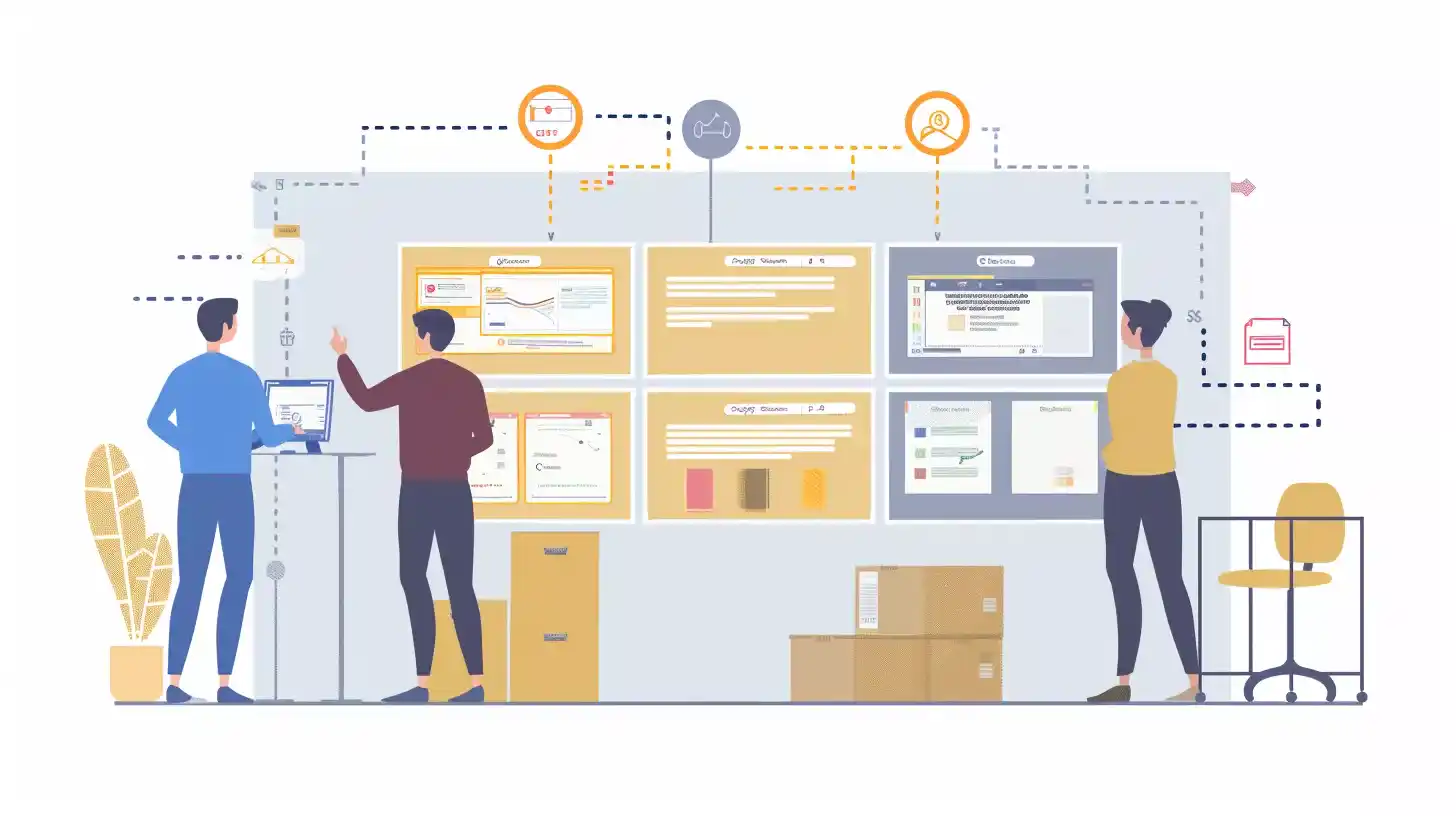Table of Contents
Scrum is an agile project management framework that helps teams work together to deliver value incrementally. It focuses on continuous experimentation, feedback loops, and iterative progress. Inspired by rugby, where a team works together to move the ball forward, it encourages teamwork and collaboration.
It consists of a Scrum Team with specific roles: Product Owner, Scrum Master, and Developers. The team participates in five events and produces three artifacts, all designed to foster transparency, inspection, and adaptation.
Key elements include:
- Sprints: short cycles of work, typically one month or less.
- Empiricism: decisions based on observation, experience, and experimentation.
- Scrum Values: Courage, Focus, Commitment, Respect, and Openness.
It is not just about following processes but embracing a mindset of continuous improvement and trust within the team.
Stay tuned for a deeper understanding of these.
Definition and Origins
Scrum is an agile framework designed to help teams work collaboratively to solve complex problems and deliver high-value products incrementally. It is structured around small, cross-functional teams working in short, time-boxed iterations called Sprints, which are typically one month or less.
Agile Framework:
- Definition: Agile is a broad methodology that emphasizes flexibility, customer collaboration, and iterative, incremental development.
- Core Principles: Agile promotes continuous improvement, adaptability, and delivering value to customers through small, frequent releases.
Brief History and Evolution
Origins:
- Inspired by Rugby: “Scrum” is borrowed from rugby, where a team works together to move the ball forward.
- First Introduced: The framework was introduced in 1995 by Ken Schwaber and Jeff Sutherland as a better way to manage software development projects.
Evolution:
- Scrum Guide: Schwaber and Sutherland created The Guide, which defines the framework, roles, events, and artifacts.
- Three Pillars: It is based on empiricism with three pillars: transparency, inspection, and adaptation.
- Scrum Values: Courage, Focus, Commitment, Respect, and Openness are essential values for a successful team.
The Role of a Scrum Master

Responsibilities:
- Facilitate Processes: The Master ensures that Scrum practices are understood and adhered to by the team. They organize and oversee events like Sprint Planning, Daily Stand-ups, Sprint Reviews, and Retrospectives.
- Remove Impediments: A key part of the role is identifying and eliminating obstacles that might slow down the team’s progress. This could involve addressing conflicts, securing resources, or resolving external dependencies.
- Coach the Team: The Master acts as a mentor, helping the team understand principles and practices. They support team members in their personal and professional growth, fostering a culture of continuous improvement.
Skills and Qualifications:
- Communication and Leadership: Effective communication skills are crucial for motivating the team and facilitating clear, open dialogue. Strong leadership abilities help in guiding the team towards their goals.
- Conflict Resolution: The Scrum Master must be adept at resolving conflicts within the team, ensuring a harmonious and productive working environment.
- Certifications (e.g., PSM, CSM): Professional certifications like Professional Scrum Master (PSM) or Certified ScrumMaster (CSM) and POPM Certification validate the Scrum Master’s knowledge and competence, enhancing their ability to lead teams effectively.
Scrum Methodology
Key Components:

- Sprint Planning: During Sprint Planning, the team sets clear, achievable goals for the upcoming sprint. They identify the tasks needed to meet these goals and plan how to accomplish them.
- Daily Stand-ups: These brief, daily meetings help the team stay aligned and informed about each other’s progress. Team members discuss what they did yesterday, what they plan to do today, and any obstacles they are facing.
- Sprint Review: At the end of each sprint, the team demonstrates the completed work to stakeholders. This is an opportunity to gather feedback and make any necessary adjustments before moving forward.
- Sprint Retrospective: After the Sprint Review, the team holds a Sprint Retrospective to reflect on the sprint. They discuss what went well, what could be improved, and how to implement changes to enhance future sprints.
Scrum Artifacts:
- Product Backlog: The Product Backlog is a prioritized list of tasks, features, and requirements that the team needs to complete. It is continuously updated based on feedback and changing project needs.
- Sprint Backlog: The Sprint Backlog contains tasks selected from the Product Backlog for the current sprint. It includes detailed plans on how the team will achieve the sprint goals.
- Increment: The Increment is the sum of all the Product Backlog items completed during a sprint. It represents a potentially shippable product, reflecting the team’s progress and efforts.
How to Start

1. Assessing Team Readiness
- Evaluate Current Processes: Understand your team’s existing workflows, strengths, and areas for improvement. Determine if the team is open to change and willing to embrace an agile mindset.
- Training and Education: Provide initial training on its principles and practices. Ensure that all team members understand the basics and are prepared for the transition.
2. Defining Roles and Responsibilities
- Product Owner: Identify a Product Owner who will be responsible for managing the Product Backlog and ensuring the team delivers value to stakeholders.
- Scrum Master: Appoint a Scrum Master to facilitate its processes, remove impediments, and coach the team.
- Development Team: Form a cross-functional team of developers, designers, and other specialists who will collaboratively work on delivering the product.
3. Setting Up the Product Backlog
- Gather Requirements: Collaborate with stakeholders to gather and document requirements, features, and tasks.
- Prioritize Items: Work with the Product Owner to prioritize backlog items based on value, urgency, and dependencies.
- Detailing Items: Break down high-priority items into smaller, manageable tasks with clear acceptance criteria.
4. Planning the First Sprint
- Sprint Goal: Define a clear and achievable sprint goal that aligns with the overall project objectives.
- Sprint Planning Meeting: Conduct a Sprint Planning meeting where the team selects items from the Product Backlog to work on during the sprint. Discuss and estimate tasks, ensuring everyone understands their responsibilities.
- Sprint Backlog: Create a Sprint Backlog containing the selected tasks and a plan for how the team will achieve the sprint goal.
5. Implementing Scrum Ceremonies
- Daily Stand-ups: Hold brief daily meetings where team members share progress, plans for the day, and any impediments they are facing.
- Sprint Review: At the end of the sprint, conduct a Sprint Review to demonstrate the completed work to stakeholders and gather feedback.
- Sprint Retrospective: Hold a Sprint Retrospective to reflect on the sprint, discussing what went well, what could be improved, and actionable steps for improvement.
Starting with it involves careful planning and a willingness to adapt. By assessing team readiness, defining clear roles and responsibilities, setting up a well-organized Product Backlog, planning the first sprint effectively, and implementing its ceremonies, you can set your team up for success in adopting the framework.
Benefits of Scrum
Enhanced Flexibility:
Scrum’s iterative approach allows teams to respond quickly to changing requirements or market conditions. By working in short sprints, teams can make adjustments and pivot as needed without causing major disruptions to the project.
Improved Collaboration:
It encourages collaboration among team members with diverse skills. This cross-functional teamwork fosters better communication, mutual understanding, and a unified effort towards common goals.
Increased Productivity:
By continuously prioritizing work items in the Product Backlog, it ensures that the team focuses on the most important tasks. This leads to more efficient use of time and resources, boosting overall productivity.
Higher Quality Products:
It promotes regular testing and frequent feedback loops. This ongoing evaluation helps identify and fix issues early, leading to higher-quality products that meet user needs and expectations.
Importance in Project Management

- Enhanced Flexibility: It allows teams to quickly adjust to changing requirements or market conditions, ensuring the project remains relevant and aligned with stakeholder needs.
- Improved Collaboration: By fostering cross-functional collaboration, it enhances communication and coordination among team members, leading to a more cohesive and effective team effort.
- Increased Productivity: It’s iterative approach ensures that the team focuses on high-priority tasks, resulting in more efficient use of time and resources and faster delivery of project milestones.
- Higher Quality Products: Regular testing and feedback loops within it help identify and resolve issues early, leading to higher-quality products that meet or exceed stakeholder expectations.
Incorporating Scrum into project management brings these significant benefits, making it a valuable framework for achieving project success and delivering value to stakeholders.
Challenges in Implementing Scrum
Common Obstacles:
- Resistance to Change: Teams and organizations often resist new methodologies due to comfort with existing processes. This resistance can slow down or even derail the adoption.
- Misunderstanding of Scrum Principles: Incorrect implementation or a superficial understanding of principles can lead to poor results. Teams might follow the ceremonies without truly embracing an agile mindset.
Solutions and Best Practices:
- Continuous Training and Education: Regular training sessions and workshops can help teams better understand and internalize Scrum principles. Keeping updated with the latest practices ensures the team evolves and improves.
- Strong Leadership Support: Leadership endorsement and active support are crucial for successful implementation. Leaders should champion the Scrum framework, providing the necessary resources and backing to overcome obstacles and drive change.
Common Scrum Mistakes and How to Avoid Them
Mistake 1: Treating Scrum as a Rigid Process
Issue: Some teams treat it as a strict set of rules rather than a flexible framework.
Solution: Embrace the agile mindset. Adapt its practices to fit your team’s unique needs while staying true to core principles.
Mistake 2: Skipping Scrum Events
Issue: Teams sometimes skip important events like Sprint Retrospectives or Daily Stand-ups.
Solution: Ensure all of its events are held regularly. These events are crucial for continuous improvement, alignment, and transparency.
Mistake 3: Incomplete or Unclear Backlogs
Issue: An unclear or incomplete Product Backlog can lead to confusion and lack of direction.
Solution: Regularly refine and prioritize the Product Backlog. Ensure it is clear, detailed, and accessible to all team members.
Mistake 4: Overloading Sprints
Issue: Taking on too much work in a single sprint can lead to burnout and missed deadlines.
Solution: Be realistic about what can be achieved in a sprint. Focus on delivering high-quality increments rather than overloading the team.
Mistake 5: Lack of Stakeholder Involvement
Issue: Ignoring stakeholder input can result in products that do not meet user needs.
Solution: Actively involve stakeholders in Sprint Reviews and other key events. Their feedback is invaluable for ensuring the product meets expectations.
Mistake 6: Poorly Defined Roles
Issue: Unclear roles and responsibilities can lead to confusion and inefficiency.
Solution: Clearly define and communicate the roles of Product Owner, Scrum Master, and Developers. Ensure everyone understands their responsibilities and how they contribute to the team’s success.
Mistake 7: Focusing Only on Tools
Issue: Over-reliance on tools can lead to neglecting the human elements of Scrum.
Solution: While tools are important, prioritize team collaboration, communication, and continuous improvement. Tools should support, not replace, these core elements.
By recognizing and addressing these common mistakes, you can enhance your Scrum practice, leading to more effective and efficient project management software.
Tools and Resources for Scrum Practitioners
Popular Tools:
- Jira, Trello, Asana: These tools help manage tasks, track progress, and collaborate efficiently. Jira is particularly popular for its robust features tailored for Scrum teams, while Trello and Asana offer user-friendly interfaces for task management.
Educational Resources:
- Courses (e.g., Coursera): Online courses from platforms like Coursera provide comprehensive training on Scrum. These courses range from beginner to advanced levels, helping practitioners deepen their knowledge and skills.
- Communities and certifications: Joining communities like Scrum Alliance or Scrum.org can provide valuable support, networking opportunities, and access to resources. These organizations also offer certifications such as Certified ScrumMaster (CSM) and Professional Scrum Master (PSM) to validate and enhance your expertise.
How does Scrum compare to other agile methodologies?
Scrum
Focus: It emphasizes short, time-boxed iterations called sprints, typically lasting 2-4 weeks. It encourages regular team collaboration and continuous improvement.
Key Components:
- Sprints, Scrum Ceremonies (Daily Stand-ups, Sprint Planning, Sprint Review, Sprint Retrospective), and Roles (Product Owner, Scrum Master, Developers).
Strengths:
- Well-defined roles and processes.
- Regular feedback loops and continuous improvement.
- Strong focus on team autonomy and collaboration.
Kanban
Focus: It uses visual boards to track work items and limit work in progress (WIP), emphasizing continuous delivery without fixed iterations.
Key Components: Kanban Boards, WIP Limits, Continuous Delivery, and Flexibility.
Strengths:
- Flexibility in handling work items.
- Easy to implement and adapt.
- Focus on optimizing flow and reducing bottlenecks.
Comparison:
- Unlike Scrum’s time-boxed sprints, Kanban allows for continuous work without fixed iterations.
- Scrum has defined roles and ceremonies, while Kanban is more flexible and less prescriptive.
Extreme Programming (XP)
Focus: Improving Software Quality and Responsiveness: XP emphasizes technical practices like pair programming, test-driven development (TDD), and continuous integration to improve software quality and adaptability.
Key Components: Pair Programming, TDD, Continuous Integration, Frequent Releases.
Strengths:
- High emphasis on code quality and technical excellence.
- Frequent releases ensure regular feedback and course corrections.
Comparison:
- XP is more focused on engineering practices and technical aspects than Scrum.
- Scrum’s structure and roles are more defined, whereas XP centers around specific development practices.
Lean
Focus: Lean aims to deliver value efficiently by eliminating waste, improving processes, and focusing on customer value.
Key Components: Value Stream Mapping, Continuous Improvement (Kaizen), and Just-In-Time Production.
Strengths:
- Efficiency in delivering customer value.
- Emphasis on continuous improvement and waste reduction.
Comparison:
- Lean principles can be integrated into Scrum practices to enhance efficiency.
- Scrum focuses on team dynamics and iterative progress, while Lean emphasizes overall process efficiency and value delivery.
Crystal
Focus: Crystal methodologies are adaptable to the project’s size and complexity, emphasizing human factors and frequent delivery.
Key Components: Human-Centric Approach, Frequent Delivery, Reflective Improvement.
Strengths:
- Flexibility to adapt processes to specific project needs.
- Emphasis on people and their interactions.
Comparison:
- Crystal is less prescriptive than Scrum, offering more flexibility in process adaptation.
- Scrum provides a more structured framework with specific roles and ceremonies.
Summary
While all these agile methodologies share common principles like flexibility, collaboration, and continuous improvement, they differ in focus, structure, and implementation.
It offers a more structured approach with defined roles and processes, making it suitable for teams that benefit from clear guidelines.
Other methodologies like Kanban and Lean provide more flexibility and focus on optimizing workflow and value delivery.
XP emphasizes technical excellence, and Crystal allows for process customization based on project needs.
Choosing the right methodology depends on the team’s requirements, project complexity, and organizational context.
Conclusion
Scrum is a powerful agile framework that enhances team flexibility, collaboration, and productivity. By breaking work into manageable sprints and fostering continuous improvement, it helps deliver high-quality products efficiently.
The Scrum Master plays a pivotal role in guiding the team, removing impediments, and ensuring the proper implementation of Scrum practices.
Embracing it streamlines project management and fosters a culture of collaboration and adaptability, driving success in various industries.